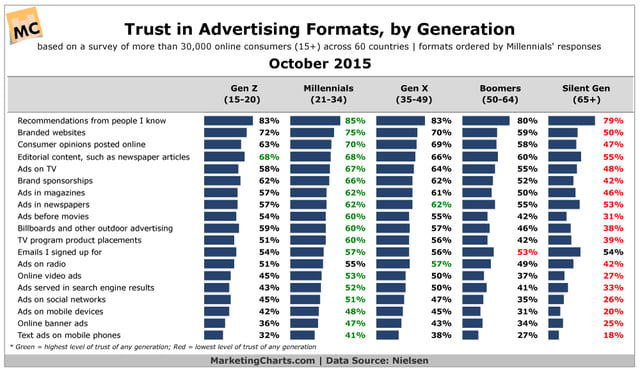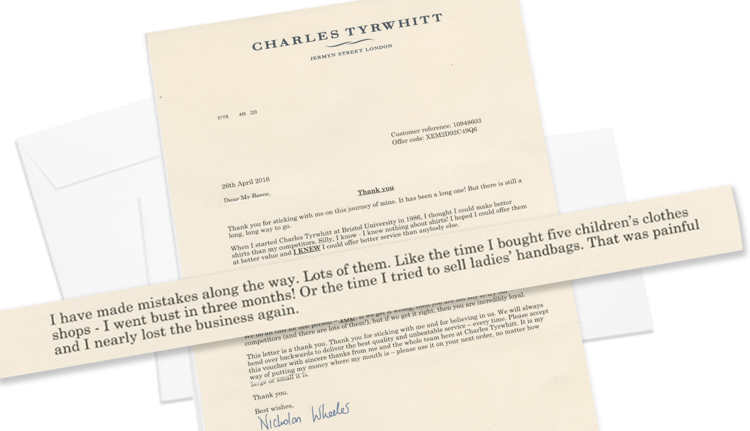From the paid to the owned to the earned (media), the element of trust has never been more at play across the marketing continuum. Add the increasing presence of ad blockers and the “banner blindness” phenomenon, and we are witnessing a truly unique time for marketers. Building trust is no longer simply the byproduct of relevant messaging or a final sale. It’s an everlasting objective that needs to be nurtured and cultivated with each step of the consumer’s journey.
Trust In Advertising
Not a minute in the day goes by that you don't hear the term “digital," and for good reason—digital marketing (and its entire ecosystem) is the undisputed wave of the future. It has benefited the small biz/start-up community immensely. It helped create some of the most impressive technologies to date, and has a much lower barrier to entry/upfront cost than its elder statesman—traditional marketing.
But new research is challenging the level of trust associated with these inherently digital tactics—consumers’ preference for digital is actually counterintuitive to what they are telling us.
According to Nielsen, traditional media outperforms online and mobile ads in trust, with 63% of consumers reporting complete or somewhat trust, followed by tried-and-true print advertising (59%). This claim was further corroborated by DMA's Print Tracking Report, which found that 56% of consumers think print marketing is the most trustworthy of all marketing channels. They point to its tactile nature—the ability to be opened and stored privately, and the fact that it is hand-delivered once a day, directly to their homes.
Consumer data leviathan Epsilon echoes the same sentiments in differing levels of trust across channels; this time, putting traditional direct marketing against its digital counterpart—email. According to their study, “The Formula for Success: Preference and Trust,” more than one-quarter of U.S. consumers (26%) say they find direct mail to be more trustworthy than email. In fact, Epsilon found that there was actually a level of enjoyment associated with more traditional, physical marketing channels—62% of all consumers actually enjoyed checking their mailboxes for print marketing.
This graph, courtesy of MarketingCharts.com, gives a clear breakdown of trustworthiness, across channels and demographics.

Key Takeaways
In the battle for consumer’s attention, we can all agree that marketing is no longer a zero-sum game. Instead of taking sides and shifting resources towards the “winner,” or in this case the “most trustworthy,” it is more valuable to refocus our attention on the most important stakeholder—the consumer. That said, 4 surefire tactics for increasing trustworthiness across marketing channels are:
1. Me vs. You: Creating trust in advertising is no small feat. It takes a company years of providing consistent and genuine value to create it. And it can all be lost in an instant. The most difficult part? Understanding that consumers don’t really care about you. As the science of advertising points to, consumers (and by extension, humans) are primarily concerned with his or her selves; self-preservation is what drives all individuals. If we are to truly engage with our audience and cultivate trust, we need to focus on speaking to the benefits of product/service offerings and incorporating second person pronouns within ad copy. For example, instead of having a company website riddled with "We are" and "We've done..." retool your messaging and speak to what you can do for your consumer, i.e. "You will gain X," "You will be able to do X."
2. Be Transparent: In an age where there are undoubtedly 20+ sources providing third-party research on your brand at any time, it is supremely important to be as transparent as possible. On top of that, your messaging needs to resonate with your brand, and your defining principles. A great, over-the-top example, men’s retailer Charles Tyrwhitt has built a considerable brand through trustworthy messaging; in addition, they are known for giving $20 vouchers per more-or-less every purchase you make. This is not only a great way to show gratitude, and build trust (and dare I say, sell more), but Charles Tyrwhitt CEO Nicholas Wheeler takes this one step further in his final consumer touchpoint—in the letter attached with each voucher (see below), Mr. Wheeler thanks each patron and acknowledges his failures in the past, owning missteps with painstaking detail. This helps create extremely potent messaging, all the while humanizing his brand.

3. 4-1-1 For Trust: The 4-1-1 Rule is a sales and marketing tactic (championed by Joe Pulizzi of the Content Marketing Institute) that has been helping new age marketers create more trustworthy messaging and better brands. This rule states that for every 4 pieces of informational and helpful content produced, there should be 1 soft and 1 hard promotion. And although this subtle tactic is often associated with building email lists and lead nurturing, it can really be applied across the board. Marketing is no longer an interruptive methodology, rooted in persuading consumers to buy-in to your brand. Consumers have more access (and more options) than ever before and they know what they want in a product or service. It is up to brands and marketers alike, to be genuinely concerned with helping solve that problem in the upfront and then slowly positioning their product or service as a solution.
4. CRM, FTW: As brands increasingly engage across channels and devices, CRM and marketing automation has become the industry standard to helping manage interactions and relationships. By leveraging a CRM, such as Salesforce, HubSpot (or ActiveCampaign for the eager start-up), you're able to gain insights into your consumers and create highly relevant messaging. Creepy (in some cases), but undoubtedly effective, the use of CRM shows your prospect/consumer that you are tailoring your messaging and interaction based on his or her preferences. The fact that you are taking the time to internalize the information and create relevant content, messaging (and eventual products/services) based on their needs, is a tell-all sign that you have trust-appeal.

